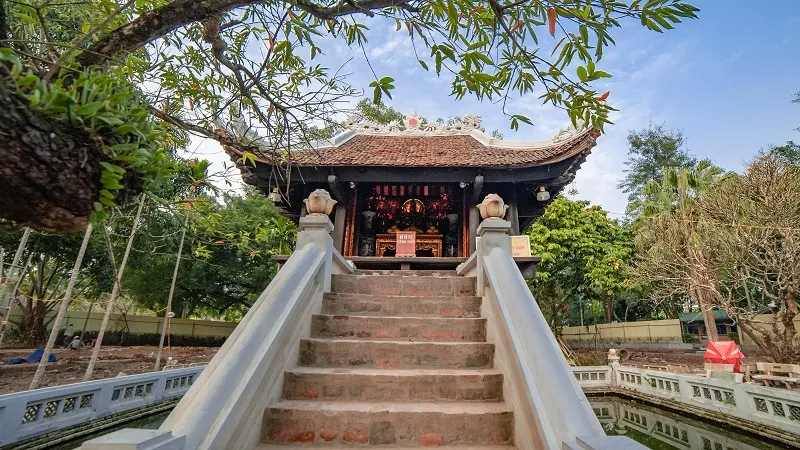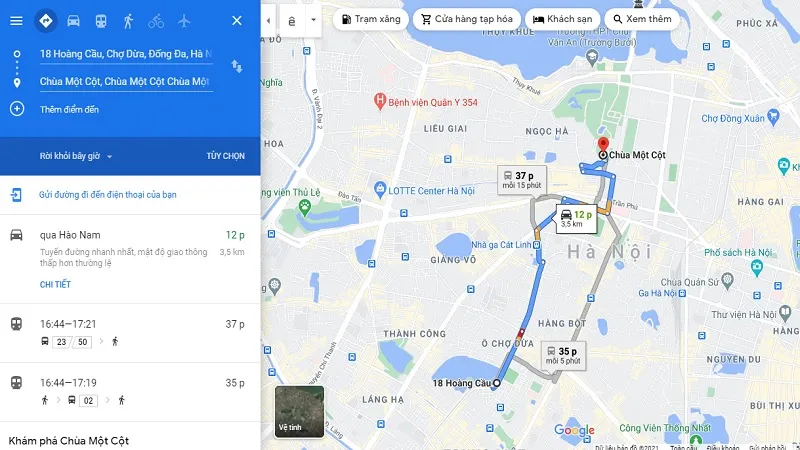One Pillar Pagoda, also known as Lien Hoa Dai, is not only a sacred temple but also a unique architectural symbol of Hanoi. With a history spanning nearly a thousand years, this pagoda holds mystical stories, deeply imbued with the cultural and spiritual values of the Vietnamese people. A visit to One Pillar Pagoda promises to bring you unforgettable experiences of history, architecture, and serene beauty in the heart of the capital.
History and Meaning of One Pillar Pagoda
One Pillar Pagoda was built in 1049 during the reign of King Ly Thai Tong. Legend has it that the king dreamed of seeing Avalokiteśvara Bodhisattva sitting on a lotus pedestal and leading him to the throne. Upon waking, the king recounted the dream to his mandarins, and the monk Thien Tue advised him to build a pagoda to pray for blessings. The pagoda was erected with unique architecture: a single stone pillar supporting a square pagoda, symbolizing a lotus flower rising from the water.

This unique architecture is not only aesthetically pleasing but also embodies Buddhist philosophy about purity, serenity, and compassion. One Pillar Pagoda has become a symbol of the longevity of Buddhism and the aspiration for a peaceful and happy life.
Unique “One-of-a-Kind” Architecture of One Pillar Pagoda
One Pillar Pagoda was recognized by the Asian Records Organization as the “Pagoda with the Most Unique Architecture in Asia” in 2012. The most distinctive feature of the pagoda is its “one-of-a-kind” architecture with a single stone pillar, 4m high and 1.2m in diameter, supporting the entire pagoda.

The pagoda has an area of about 3 square meters, made entirely of wood and roofed with tiles. The pagoda’s roof is designed with curved knife-edge shapes, adorned with dragon figures, creating a majestic and sacred beauty. Linh Chieu Lake surrounding the pagoda further enhances the serene and harmonious beauty of this architectural work.
Steps Leading to the Main Hall
To enter the pagoda, visitors must walk up 13 wide steps, approximately 1.4m wide. On both sides of the steps are brick walls, on which stone steles are attached, introducing the history of the pagoda.

These steps are not only a pathway but also a part of the historical relic, bearing the marks of time and the changes of history.
Altar of Avalokiteśvara Bodhisattva
Inside the pagoda, the statue of Avalokiteśvara Bodhisattva is placed at the highest position, on a gilded wooden lotus. Surrounding it are bronze censers and vases, creating a solemn and serene space.

Although not overly elaborate, the arrangement still exudes beauty and a unique style, bringing a sense of peace and tranquility to visitors.
Discover Other Special Features at One Pillar Pagoda
Besides its unique architecture, One Pillar Pagoda also has many other special features that attract visitors:
- Bodhi Tree: The Bodhi tree in the pagoda’s grounds is a gift from the President of India to President Ho Chi Minh. The tree was propagated from the very Bodhi tree under which the Buddha Shakyamuni attained enlightenment, carrying sacred and noble significance.
- Linh Chieu Lake: Linh Chieu Lake surrounding the pagoda creates a serene and harmonious space. The blue lake reflects the pagoda, creating a beautiful picture.

Visiting Tips for One Pillar Pagoda
To have a complete visit to One Pillar Pagoda, you should note the following:
- Opening hours: The pagoda is open from 7:00 AM to 6:00 PM daily.
- Entrance fee: Free for Vietnamese citizens, 25,000 VND/ticket/person for foreign visitors.
- Dress code: Dress respectfully and modestly when entering the pagoda.
- Attitude: Maintain a respectful attitude, avoid making noise, and disturbing the solemnity of the pagoda.
Getting to One Pillar Pagoda
One Pillar Pagoda is located in the center of Hanoi, making it easily accessible by various means of transport:
- Bus: Bus routes 09, 16, 22, 32, 34 all have stops near One Pillar Pagoda.
- Motorbike, car: You can travel along Giang Vo – Nguyen Thai Hoc – Hung Vuong streets, Van Cao – Thuy Khue – Hung Vuong streets, Ton Duc Thang – Chu Van An – Dien Bien Phu streets.
- Taxi, motorbike taxi: These are convenient and fast means of transportation.

One Pillar Pagoda – A Must-Visit Destination in Hanoi
One Pillar Pagoda is not only a historical and cultural relic but also a symbol of Hanoi. With its unique architecture, long history, and deep spiritual significance, this pagoda is a must-visit destination for anyone visiting the capital. Coming to One Pillar Pagoda, you will admire the unique architectural beauty, learn about Vietnamese history and culture, and feel the serenity and peace in your soul.
Hopefully, with the above sharing, you will have a meaningful and memorable visit to One Pillar Pagoda.